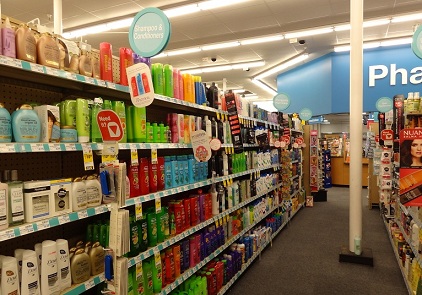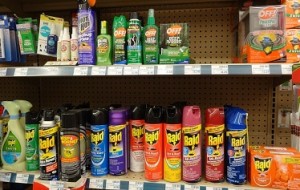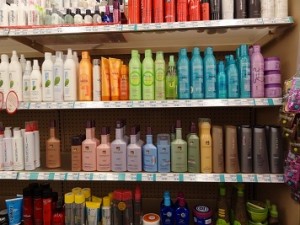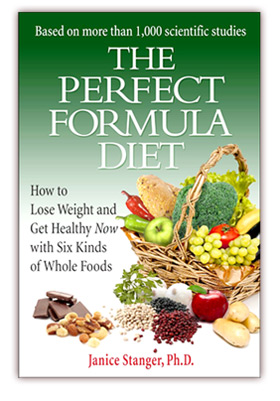
It's no coincidence that the aisles of products with chemical ingredients in most drug stores ends at the pharmacy counter
Must-Have Information on Harmful Chemicals in Your Home
Whether you are buying personal care and household products for yourself or as a gift for others, you need to be aware of the toxic substances that lurk in these products. Manufacturers lure you in with sexy ads and bright packaging. Chemical-laden choices promise to make your life easier and more fun.
Don’t fall for it. You are probably washing your hair, moisturizing your skin, and cleaning your kitchen with harmful petrochemicals. These toxic materials end up in your body, often dissolved in your fat. The residues wash downstream to deform and kill wildlife. No effective laws slow down industry practices in this area, and many ingredients are not even listed on the packaging. Over 85,000 manmade chemicals are now in use.
There is another way. You can protect yourself, your family, and the planet with facts to make nontoxic choices. But where will you get unbiased information to avoid toxic materials? The popular media, industry groups, and anyone with a monetary interest in the status quo are not going to be reliable guides.
Here are five top sites of nonprofits that are not afraid to speak out with the truth about personal care and household products. These sites have so much useful information you might get overwhelmed. To avoid this, a helpful strategy is to browse one or two sites with a specific product in mind. It might be shampoo, toothpaste, soap, baby products, or kitchen cleaners. See what you can find. Pick up some easy tips to start implementing. Any change in the right direction is better than doing nothing.
If you make every trip to the store a learning experience, soon you will be well down the road to a nontoxic body and nontoxic house. The important thing is to get started and don’t expect to make all changes overnight. It’s easy to keep your head in the sand

You can ignore the risk, but that does not reduce the potential hazards of most commercial insectiicides
and be put off by fear of knowing. But actually it’s much scarier not to know. Soon you will be teaching others.
You definitely don’t need a degree in chemistry. Read labels. If you can’t pronounce an ingredient or don’t know what it is, it’s a safe bet you don’t want to put it on your body or give it as a gift. Remember everything you put on your skin gets absorbed through your skin into your bloodstream and eventually your cells. Ditto with chemicals you breathe with sprays and fragrances. Time to begin learning and exploring.
SITE ONE. Environmental Working Group. This comprehensive site showcases toxic materials as a public health issue. The information is specific enough to start you off making better choices after five or ten minutes browsing.
Here are a few of the site’s most to-the-point pages to get you started.
Health tips has a series of guides and tip sheets on everything from baby products to cell phone radiation to healthy pets and safe drinking water.
Chemical index takes you through many toxic chemicals and lets you know why they are dangerous. You will be a much smarter

Note how the bottles are all colorful and feel smooth and pleasant if you pick them up. Manufacturers design packaging to seduce your natural love of color and smooth texture - which spring from our human origins as fruit eaters, loving the color and texture of ripe fruit.
label reader after browsing this information.
The Skin Deep cosmetics database lets you look up specific personal care products to see if they contain chemicals of concern and to find the least toxic alternatives.
SITE TWO. Organic Consumers Association. OCA features a database to help you find less toxic products and services in your area – for example, pet services, pest control, clothing, and health care practitioners.
Their e-newsletter, Organic Bytes, has taken a lead role in battling Monsanto and other companies pushing genetically modified organisms (GMO) crops. This newsletter, which you can subscribe to for free, does an outstanding job explaining why these GMOs are so terribly dangerous and what you can do about it.
SITE THREE. The Campaign for Safe Cosmetics. As soon as you click on this site, you will see a short, entertaining video on the toxins in “stuff” and how you can start to make healthier choices. Learn which baby shampoo is carcinogenic.
The Science tab on this site is a wonderful information source on specific chemicals to watch out for. I strongly recommend downloading the free report Not So Sexy: The Health Risks of Secret Chemicals in Fragrance. Even just reading through the first few pages of this report will transform your understanding of the toxic mess that industry has been selling you in glamorous ads.

Eagles were among the many birds severely endangered until Rachel Carson wrote her classic book Silent Spring. For this, she was ferociously attacked by chemical companies who denied the harmful effects of DDT and questioned Ms. Carson's scientific credentials.
SITE FOUR. Silent Spring Institute. This nonprofit carries on the legacy of Rachel Carson. This brave scientist faced down industry scorn and wrath to let the public know toxic chemicals were wiping out birds by making eggshells too thin for the chicks to hatch.
The Research page highlights specific studies of chemicals found in the bodies of various Americans. You might be amazed at the
findings. Breast cancer is a special area of concern for this nonprofit.
SITE FIVE. Environmental Health News. Most news organizations concentrate on the predictable– bickering politicians, misbehaving celebrities, the latest stock market gyration. Not Environmental Health News. Their staff has to be working 24/7 to
bring planet-changing information to the public’s attention, all for free.
Subscribe to their daily e-newsletter Above the Fold. Every day you will get information on really important topics that will shape your life and the future of the next generation. You will be in the most informed elite and prepped to make a true difference.
Please explore these top five sites to find essential information to protect yourself and the planet from harmful chemicals. These nonprofits are courageous in battling established interests and remaining free of big-money influence.
If you want to keep learning, you might check out this post on The President’s Cancer Panel April 2010 report Reducing Environmental Cancer Risk. This hard hitting report, which was bashed by polluting industries and then promptly ignored, clearly outlines the dangers from carcinogenic chemicals and provides fascinating must-know information and memorable quotes.

Amphibians, such as this frog, are the animals most vulnerable to downstream pollution from chemicals in personal care and household products
Intrigued? Now you can use our Whole Foods Blog Finder to target informative, fun postings on whole foods, plant-based nutrition. Quick information at no cost!
Blog posting by Janice Stanger, Ph.D. Janice authored The Perfect Formula Diet: How to Lose Weight and Get Healthy Now With Six Kinds of Whole Foods. This easy-to-follow eating plan is built on a whole foods, plant-based diet that can prevent, and even reverse, most chronic disease as well as get you to your perfect weight. The book has two chapters on getting toxic chemicals out of your life. Janice is on a long-term mission to seek out nontoxic personal care and household products that won’t harm her or wildlife.
Tags: Above the Fold, Campaign for Safe Cosmetics, cancer, environmental degradation, Environmental Health News, Environmental Working Group, getting healthy, household products, Organic Bytes, Organic Consumers Association, Perfect Formula Diet, personal care products, President's Cancer Panel, Silent Spring Institute, Skin Deep cosmetics database, toxic chemicals




